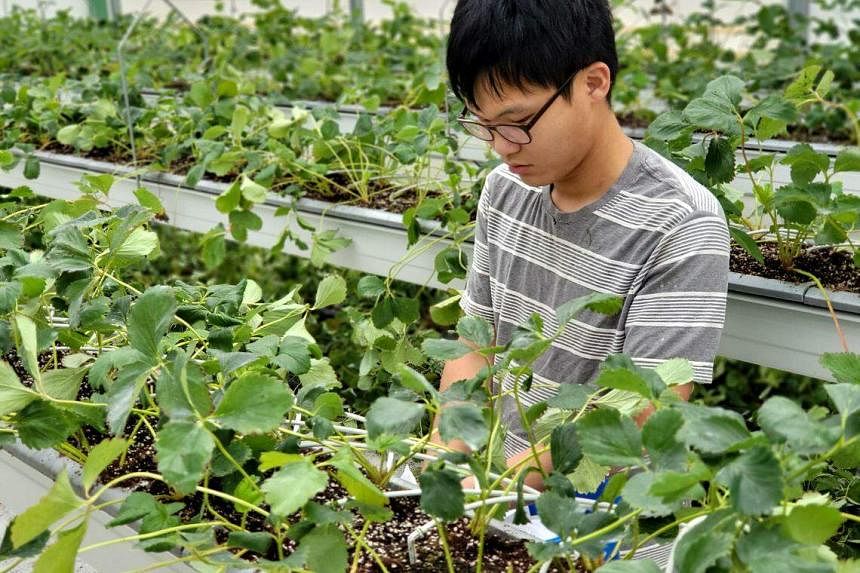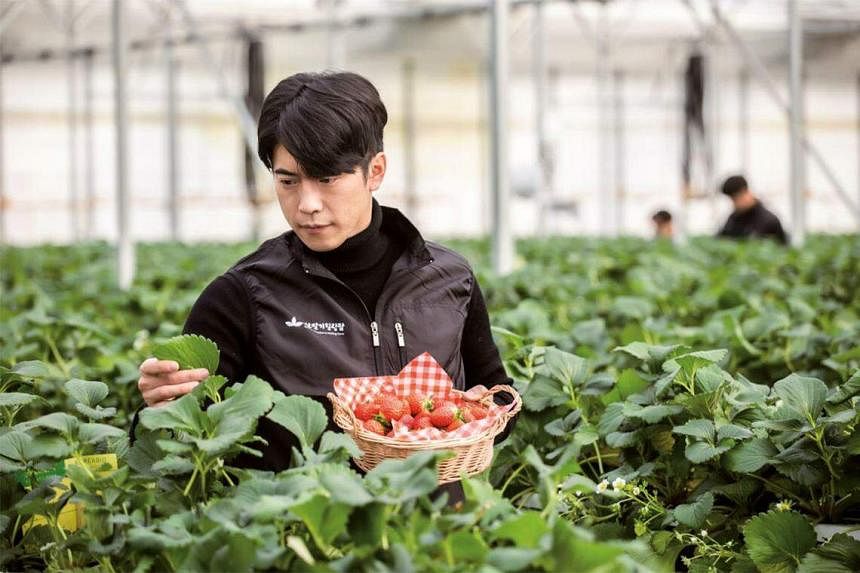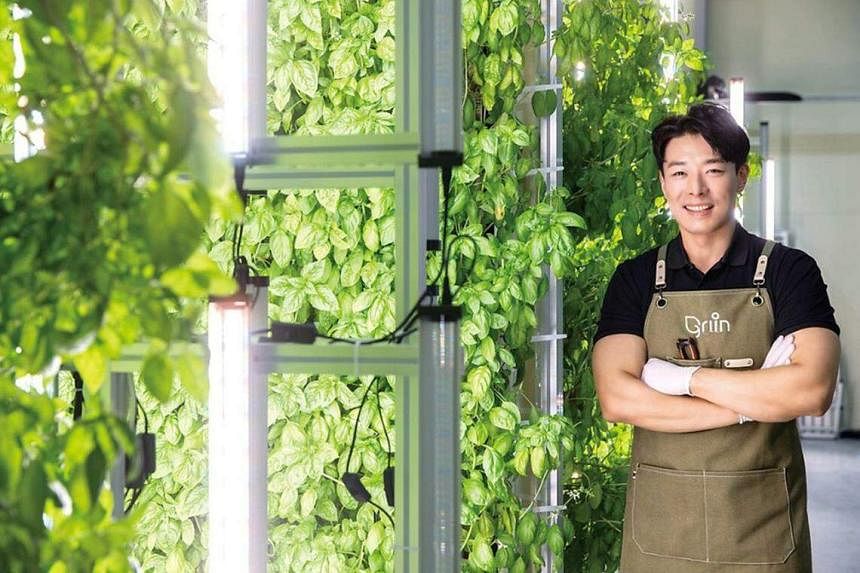POCHEON/GIMPO, South Korea – Mr Kang Tae-yang was working towards his dream of being a pilot when the Covid-19 pandemic hit.
Seeing how the aviation industry collapsed when borders closed, the 29-year-old decided to switch to something totally different – farming. But he did not give up the blue skies to toil under the hot sun.
He is now training in the city of Pocheon, 50km north-east of Seoul, to become a “smart farmer” – a new-age crop grower who works in sheltered greenhouses and uses technology to increase yield and efficiency.
He is also viewed as a start-up founder, not a blue-collar worker.
This is why more young people like him are drawn to such jobs, as the South Korean government embarks on a push to groom more young farmers under 40 to modernise the industry.
“Work can be tough but I really enjoy the smell of nature,” said Mr Kang, whose interest in agriculture was piqued a few years ago on a working holiday in Australia that opened his eyes to high-tech farming.
“I’ll be able to derive more joy in the future when I have my own farm and run my own business.
“I’m thinking of growing strawberries and mangoes, and maybe wasabi too.”
Korean hot peppers are on the mind of Mr Oh Jung-woong, who is also training to become a farmer after Covid-19 disrupted his plan to study in Canada.
The 23-year-old is acquiring 23,000 sq m of farmland in Pocheon to build a smart farm, where he intends to live and work.
“Since I couldn’t find any other job, I decided to do farming, which I’m good at and have been interested in since I was young,” he said.
“But it’s too hot in the day, so I will work in the evenings and early mornings.”

Mr Ahn Hae-sung is a role model for such young farmers. He quit his job as a researcher at carmaker Hyundai to start Pocheon Strawberry Healing Farm in 2019.
The 42-year-old earns 500 million won (S$522,000) a year from growing strawberries and lettuce.
He also provides on-the-job training for about 1,000 aspiring farmers a year.
“Being a farmer in the past meant having a low social status. Nowadays, agriculture is seen as a start-up that requires significant preparation and financial resources,” said Mr Ahn, who also runs a YouTube channel called Ahn’s Farm TV.
“Young people don’t just want to learn how to grow crops in the soil. They want to learn about entrepreneurship and technologies used in agriculture.
“They want to start a business that uses agricultural technology to generate income.”

This is part of the kwichon trend, in which urbanites head for the countryside to escape skyrocketing property prices and the stress of city life. The average price of an apartment in Seoul doubled from around 600 million won to 1.2 billion won from 2017 to 2022.
In 2021, a record 515,000 people left the cities for rural areas, an increase of 5.6 per cent from the year before, according to the Ministry of Agriculture, Food And Rural Affairs (Mafra). Young households who took up farming in the countryside numbered 1,507 in 2021, up from 1,209 in 2019.
It is a trend embraced by the government. South Korea’s farmers are ageing, and tend to stick to older methods of farming.
The nation’s food self-sufficiency fell from 70 per cent in the 1980s to 45.8 per cent in the 2020s, thus the need for fresh blood.
The government aims to nurture 30,000 young farmers by 2027, in the hope they will make up 10 per cent of all farmers by 2040. As at 2022, there were 12,000 farmers under the age of 40.
In October 2022, Mafra announced a host of incentives to help ease them into the field. These include on-the-job training, a monthly stipend of up to 1.1 million won in the first three years, rental farmland and low-interest loans of up to 500 million won to be repaid over 25 years.
It is important to draw young people into agriculture because their knowledge of advanced technologies will help to transform the traditional industry into a high-tech one, said Mafra’s Agricultural Policy Bureau director-general Park Su-jin.
“Young farmers are generating profits by developing innovative, unconventional products and exploring new sales channels,” she said.
She cited one farmer who developed a popular breed of ultra-sweet tomatoes by injecting stevia sweeteners into them, and an agricultural firm which created a “potato bun” – with a specific breed of spuds – that went viral due to its resemblance to a real potato.
Smart farms now make up just 1 per cent to 2 per cent of the domestic market. Mr Ahn expects the figure to grow rapidly alongside government plans to increase smart farms’ market share to 30 per cent by 2027.
“Agriculture will be transformed digitally. Traditional farming practices will gradually disappear, while smart greenhouses and farming technologies will become more prevalent,” he said.
Looking back at his white-collar days at Hyundai, Mr Ahn said he was “just an employee with limited autonomy... receiving salary without much sense of achievement”.
He added: “Now I can freely pursue the business vision I have and gain economic freedom. I get much higher satisfaction from farming compared with my corporate job.”
Mr Francisco Kweon, 38, shares these feelings despite a rocky start in 2014 after previously working in a trading firm in Singapore.
His first attempt at growing South Korean staples such as potatoes and scallions on a small plot of land in Gimpo, west of Seoul, caused him to “lose tonnes of money” while earning less than US$2,000 (S$2,700). He blamed his lack of experience and started over in 2016, growing basil and herbs.
This time, he developed a smart farming system leveraging technology, collaborated with older farmers with excess land for him to utilise and set up a distribution channel for his produce.

The new model was so successful that he has since implemented it in five farms run by others, with 25 more in the queue and more than 190 requests made. He revealed that his company, Griin Agriculture, had total sales of US$4 million in 2022, and he signed US$30 million worth of contracts in 2023.
“There are 18 types of farm products that can be very profitable under our system, for example, spinach, lettuce and mustard greens,” said Mr Kweon, who also gives lectures to aspiring young farmers on his experience.
His advice for newbies?
“Stay away,” he deadpanned, before adding: “Farming is hard... Consider carefully before you become a farmer. I can never sleep more than five hours a day and I work seven days a week. I’m more stressed than ever.
“But I’ve gained recognition from older farmers and built a solution to help small and medium-sized farms, which is personally satisfying for me.”
Additional reporting by Suin Jung


